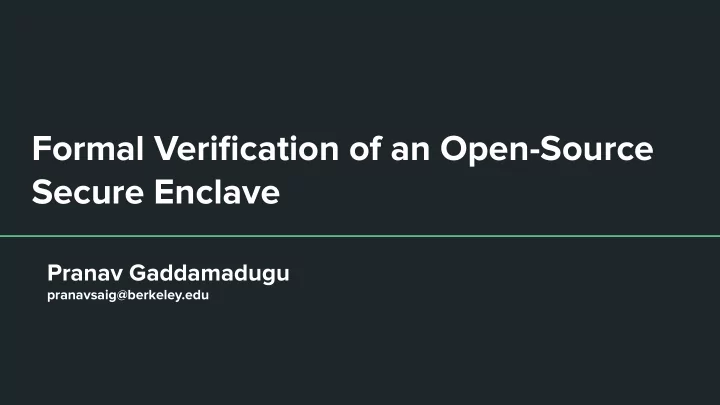

Formal Verification of an Open-Source Secure Enclave Pranav Gaddamadugu pranavsaig@berkeley.edu
Problem Definition ● Verifying hyperproperties about the Keystone Security monitor ● Secure Remote Execution (SRE) : a 2-safety hyperproperty that can be decomposed into guarantees on: ○ Integrity ○ Confidentiality ○ Measurement Previous models assume a fixed implementation of a TEE, our work ● allows for easy compositional verification of various hardware components and Keystone plugins
Prior Work ● ‘A Formal Foundation for Secure Remote Execution of Enclaves’ ○ Subramanyan, Sinha, et al. at CCS ‘17 ● Introduces a model of a Trusted Abstract Platform (TAP) ● Defines three separate adversary models: M, MC, MCP ○ ● Proves SRE for Intel SGX and MIT Sanctum
Proof Methodology ● Show that TAP guarantees SRE under the three adversary models ● Show that models of SGX and Sanctum are refinements of the TAP model under specific adversarial parameters
Redesigning the Model for Modular Verification ● Translated TAP model from Boogie to UCLID5 ○ Toolkit for formal specification and verification of compositional systems ○ Suited for reasoning about the composition of Keystone and additional plugins ○ Future work on automatic invariant generation ● Extensions to UCLID5 ○ Support for modular procedure-level verification, additional features for easier programmability, modifications to proof techniques
Extending the Model ● Extension of the adversary model to physical attackers ○ Enclave platforms also provide guarantees ‘physical attackers’ ○ We define a physical attackers as ‘an adversary with the capability to observe or tamper with any signal leaving the chip package’ ○ Involves the addition of an abstract memory encryption engine, as well as a semantic embedding of ciphertext and plaintext
TAP Model Design
Keystone Model and Augmentation
Future Work ● Write the Abstract MEE model and augment proofs to show that TAP+MEE provides SRE under a physical adversary ○ Refinement proof (once Memory Encryption is added to Keystone) ● Exploring automatic invariant generation Implementing a native SyGuS solver in UCLID5 ○ ○ Generating invariants based off of TAP and Keystone model sketches
Thank you! Any questions?
Recommend
More recommend